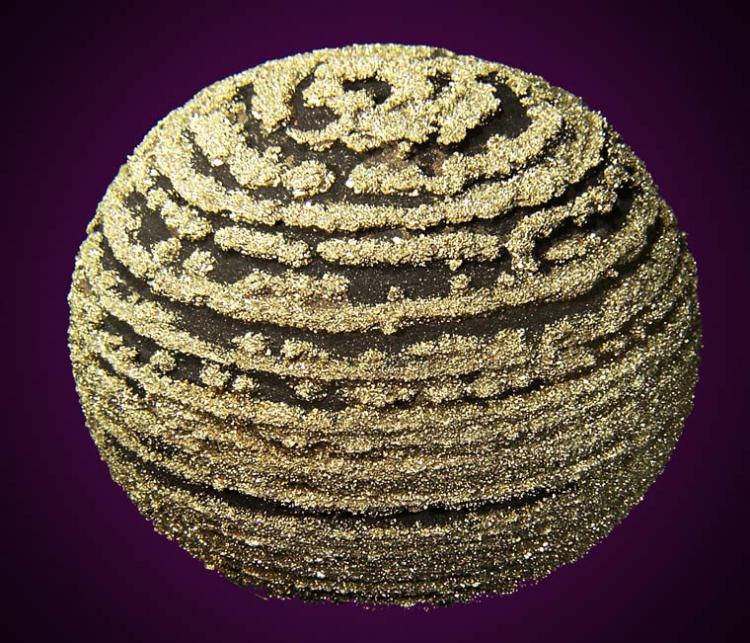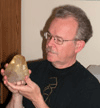| View previous topic :: View next topic |
| Author |
Message |
perrush
Joined: 08 Sep 2012
Posts: 1
Location: Oevel


|
 Posted: Sep 08, 2012 06:33 Post subject: Pyrite disease Posted: Sep 08, 2012 06:33 Post subject: Pyrite disease |
|
|
Hi All,
I just started to collect minerals (had an interest for many years, but never started). My approach maybe a little bit different than others. I choose one mineral and try to find out (and collect) as much as I can about that one mineral.
Well, my first pick was ... pyrite
I've read about pyrite rot and was wondering which specimens are possibly affected. Theoretical all forms of FeS2 can degrade. But in practise I don't think the disease affects solid cubes and pyrit balls (or does it ?). On the other hand I guess all forms of fine crystals on a surface are very vulnarable.
Is this thinking correct ?
I ask this in particular because I bought a ball like the one in the attachment. Afterwards I realised that the crystals could very well be fragile to rot.
------
I've read a lot about the conservation of pyrite. There are a lot of solutions being given, but I miss one (fairly easy) solution.
If you can exclude oxygen from your specimen, rot shouldn't occur. Excluding oxygen seems difficult BUT has anyone ever tried to use CO2 ?? CO2 is heavier than air. You can literally pour CO2 into a cup or bowl. So if you place your specimen in a container, pour the CO2 into the container and close it with a lit. There should be very little O2 in container. Adding a sack of silicagel would make the picture perfect.
greetz
Stefan
| Description: |
pyrite
Hechi, Guangxi, Dongchuan, Yunnan Province, China
3"
taken from http://www.treasuremountainmining.com |
|
| Viewed: |
15546 Time(s) |

|
|
|
| Back to top |
|
 |
Pete Richards
Site Admin

Joined: 29 Dec 2008
Posts: 828
Location: Northeast Ohio



|
 Posted: Sep 08, 2012 08:38 Post subject: Re: pyrite disease Posted: Sep 08, 2012 08:38 Post subject: Re: pyrite disease |
|
|
The goal is to stop the exchange of air near the specimen. I have used adhesive-backed metal foil to seal the joint in thumbnail boxes. Larger specimens can be stored in glass jars with tight-sealing lids - canning jars, for example. The oxygen that is closed in with the specimen will do a tiny bit of damage, but once it is used up no further damage will occur. Even if the seal is not perfect, it will greatly slow the supply of oxygen to the surface of the specimen, and increase its life span correspondingly.
Fine grained pyrite and/or marcasite are much more of a problem than large solid crystals because of the large surface area available for oxidation.
_________________
Collecting and studying crystals with interesting habits, twinning, and epitaxy |
|
| Back to top |
|
 |
J. A. Woolley
Joined: 15 Jul 2011
Posts: 6
Location: Texas


|
 Posted: Sep 08, 2012 09:13 Post subject: Re: pyrite disease Posted: Sep 08, 2012 09:13 Post subject: Re: pyrite disease |
|
|
Stefan,
Your pyrite ball concretion is a good example of sedimentary pyrite, which is much more likely to be affected by pyrite disease than more well-crystallized pyrites that formed in higher temperature environments. It is most important to keep them away from moisture and humidity.
There is an excellent discussion of this topic on mindat.org if you have not encountered it already:
https://www.mindat.org/forum.php?read,19,149266,page=1
Cheers,
Jonathan
|
|
| Back to top |
|
 |
GneissWare

Joined: 07 Mar 2008
Posts: 1287
Location: California



|
 Posted: Sep 08, 2012 10:37 Post subject: Re: pyrite disease Posted: Sep 08, 2012 10:37 Post subject: Re: pyrite disease |
|
|
| A simple rule of thumb is to avoid pyrite specimens that smell like sulfur. I believe that the smell indicates free sulfur (more Marcasite?) available to combine with atmospheric moisture which produces H2SO4. In my experience, it is these specimens that degrade faster. Rock Currier, if I recall correctly, said most Pyrite eventually will degrade. On the other hand, I have a few that are from 100 year old collections that still seem fine.
|
|
| Back to top |
|
 |
Pierre Joubert
Joined: 09 Mar 2012
Posts: 1605
Location: Western Cape



|
 Posted: Sep 08, 2012 11:29 Post subject: Re: pyrite disease Posted: Sep 08, 2012 11:29 Post subject: Re: pyrite disease |
|
|
| GneissWare wrote: | | ...I have a few that are from 100 year old collections that still seem fine. |
Is there reason for panic? The few pyrites we have show no signs of corroding.
_________________
Pierre Joubert
'The tree of silence bears the fruit of peace. ' |
|
| Back to top |
|
 |
Jordi Fabre
Overall coordinator of the Forum

Joined: 07 Aug 2006
Posts: 4900
Location: Barcelona



|
|
| Back to top |
|
 |
Pete Modreski
Site Admin

Joined: 30 Jul 2007
Posts: 709
Location: Denver, Colorado



|
 Posted: Sep 10, 2012 15:59 Post subject: Re: Pyrite disease Posted: Sep 10, 2012 15:59 Post subject: Re: Pyrite disease |
|
|
| I'd say it seems that pyrite from each particular locality/occurrence has its own particular propensity to decompose, or not; so, I think the best intelligence could come from someone who has first-hand experience with this particular occurrence of pyrite, the spheres from China (and for which I myself have no first-hand knowlege). As said, sedimentary pyrite is most succeptable; crystalline pyrite from higher-temperature ore deposits is usually are free of the problem, but some sedimentary pyrites decompose rapidly, others, seem immune. The "smelling like sulfur" guideline does sound like good advice. Decomposition tends to be much enhanced by damp, humid atmospheres, vs. dry climates. Recent work has indicated that bacterial action actually plays a role in the decomposition, and I think (?) some of the reports that had been referred to, may discuss that. I have at least one of those pyrite spheres from China; all I know is, it hasn't decomposed yet (last I looked). Best of luck!
|
|
| Back to top |
|
 |
James Catmur
Site Admin

Joined: 14 Sep 2006
Posts: 1347
Location: Cambridge



|
 Posted: Sep 11, 2012 01:58 Post subject: Re: Pyrite disease Posted: Sep 11, 2012 01:58 Post subject: Re: Pyrite disease |
|
|
Pete
Denver is a dry climate so we need to know who has them in a a humid climate
James
|
|
| Back to top |
|
 |
|


